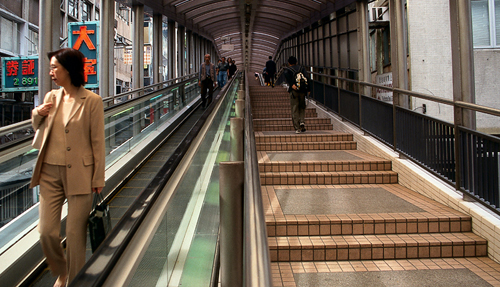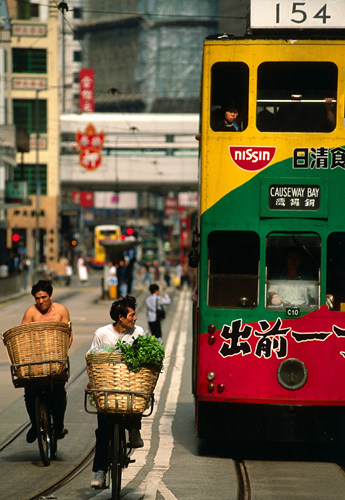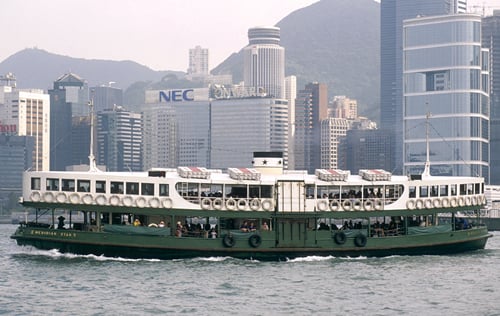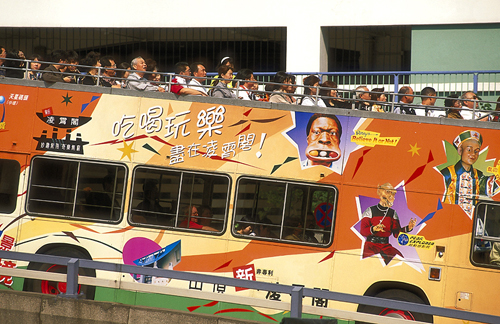The Escalator The
series of escalators in the steep Mid-Levels district of northwest Hong
Kong Island is designed for commuters, but most appreciated by
sightseers who can rest their legs and enjoy the fascinating sights.
Take a stately (and free) ascent past busy street scenes, traditional
shops and apartment windows. .

Mid-Level escalator
Trams Hong
Kong’s trams date back to 1904, making this one of the oldest
continuously used tram systems in existence. They are still one of the
best ways of exploring the Hong Kong Island shoreline. Trainspotter’s
trivia: it’s also the only double-decker tram system in the whole world.

Old-fashioned tram
The Peak Tram Since
1888, this funicular railway has made the jaw-dropping ascent of
Victoria Peak, and remains a must for visitors. Under the unwritten
rules of colonial times, certain seats were reserved for high officials;
now, seating is an amiable free-for-all. .
Airport Express Link Should
your attention span wane on the fleeting 24-minute ride from the
airport to Central, the AEL offers personal TVs in the back of every
seat. Bright, shiny and a joy to use. MTR Hong
Kong’s underground railway is a world leader, handling three million
people a day with rapid and robotic efficiency. Signs are in both
English and Chinese, delays are almost unheard of, and with fares
starting from the price of a cup of coffee, a trip around the city is
surprisingly affordable, too. Ferries The fabulous Star Ferry
connects Hong Kong Island to Kowloon. Pay half the price of a cup of
coffee for a first-class view of one of the world’s most remarkable
harbours and skylines. Other ferries connect Hong Kong to the outlying
islands and parts of the New Territories .

Star ferries
Rickshaws There
are just seven rickshaws left in all Hong Kong, their elderly drivers
earning a living by charging tourists for photos. Don’t ask for a ride,
unless you want richly-deserved abuse from passers-by: these old guys
can’t make their way halfway down the road without collapsing in an
exhausted heap.

Rickshaw
Taxis Hong
Kong cabbies are as psychotic as big city cabbies everywhere. Their
rudeness is legendary, but you probably would be too if you had to deal
with Hong Kong traffic all day, every day. Fortunately, tighter policing
means that overcharging is now a rare occurrence. Limousines On
a per capita basis, Hong Kong probably has more Mercedes and Rolls
Royces than anywhere else in the world. Some 15 of the latter are owned
by the Peninsula Hotel alone – including a Phantom II dating from 1934. Buses Hong
Kong’s double-decker buses are a British legacy, although these mostly
come air-conditioned and (in a universally loathed development) with
onboard TVs blaring ceaseless advertising. The low cost of using them
may help you overcome this irritant.

Open-top bus
Top 10 Sights from the Escalator
Escalator Itself The world’s longest covered escalator system is a sight unto itself. Commuters Some 211,000 people ride the system daily, bypassing the Mid-Levels’ notorious traffic snarls. Central Market The escalator begins opposite this agreeably raucous fruit and vegetable market. BoHo (“Below Hollywood Road”) The start of the journey takes you through the heart of this hip quarter. SoHo (“South of Hollywood Road”). Alight at the first stop and walk a block uphill for trendy bars and eateries. Hollywood Road Home to antique shops, galleries, nightclubs, bars and the historic Man Mo Temple. Galleries Several en route, many specializing in the bright new wave of Chinese art. Rednaxela Terrace So
named because a 19th- century signwriter wrote “Alexander” from right
to left, in the Chinese manner. Uncorrected to this day. Jamia Masjid Mosque Also known as the Shelly Street Mosque, built in 1915. One of three mosques catering to 70,000 Muslims. Conduit Road Where SoHo peters out, and the Mid-Levels begins amid forests of upscale apartment blocks.
|